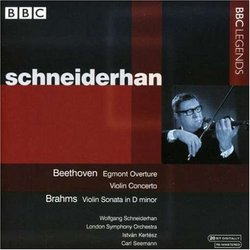| All Artists: Ludwig van Beethoven, Johannes Brahms, Istvan Kertesz, London Symphony Orchestra, Carl Seemann Title: Beethoven: Egmont Overture; Violin Concerto; Brahms: Violin Sonata in D minor Members Wishing: 0 Total Copies: 0 Label: BBC Legends Original Release Date: 1/1/2007 Re-Release Date: 10/23/2007 Genre: Classical Styles: Chamber Music, Forms & Genres, Concertos, Historical Periods, Classical (c.1770-1830), Instruments, Strings, Symphonies Number of Discs: 1 SwapaCD Credits: 1 UPC: 684911421729 |
Search - Ludwig van Beethoven, Johannes Brahms, Istvan Kertesz :: Beethoven: Egmont Overture; Violin Concerto; Brahms: Violin Sonata in D minor
 | Ludwig van Beethoven, Johannes Brahms, Istvan Kertesz Beethoven: Egmont Overture; Violin Concerto; Brahms: Violin Sonata in D minor Genre: Classical
|
Larger Image |
CD Details |
CD ReviewsA first rate recording that demands a place in your collecti Alice Taniyama | Houston, Texas United States | 01/23/2009 (5 out of 5 stars) "Although Wolfgang Schneiderhan is not as well remembered as the likes of Oistrakh, Milstein, Menuhin, and Heifetz, he was at the very least close to their level back in his day, and it would be wrong to judge him harshly merely for his lack of first tier name recognition. After all, who in the West had heard of Oistrakh until the 1950s? Fame can be fickle. Schneiderhan made the Beethoven concerto one of his concert staples, and after listening to this recording, you'll see why. His interpretation works on every level, his sound is gorgeous and powerful, and, like the other great performers of Beethoven, he shows restraint by refraining from adding unnecessary, distracting flourishes that work so well in lesser concertos but merely drag down the true greats. If you want empty virtuosity, go listen to Tchaikovsky or Paganini. If you want music, here is Beethoven. However, the real reason you want this recording is for Schneiderhan's candenzas. Most performers stick to the standard Kreisler candenza, but the Schneiderhan has his own. Sort of. Beethoven liked his violin concerto enough that he, in a fit of possibly irrational exuberance, wrote a second version for piano. While a single hearing of the piano version would probably convince most that there is a reason the violin version gets considerably more exposure in concerts and recordings (because the violin sings much better than the piano in a concerto whose first movement is the apex of lyrical solo playing, and because if you want something by Beethoven for the piano, you have so many better options), it is important because Beethoven actually wrote candenzas for this version. Schneiderhan took these candenzas and transcribed them for violin, and that is what he presents on this recording. While not the world's greatest candenzas, they are still cadenzas, and furthermore, they are bits of music by Beethoven that most people have never heard. True, parts of the first movement's cadenza sound like Beethoven wrote them as a joke, and they prevent this from being anyone's definitive recording of the Beethoven violin concerto, but one cannot truly love the piece without looking at everything Beethoven himself intended for it, and thus Schneiderhan becomes a necessary part of anyone's complete devotion to this example of some of the world's greatest music. The Egmont and the Brahms sonata are icing on the cake. They are worth the price of the recording on their own, but you're really buying this for the concerto." A live Beethoven Violin Concerto that's just shy of great Santa Fe Listener | Santa Fe, NM USA | 03/24/2009 (4 out of 5 stars) "Only a handful of orchestra concrtmasters have made a parallel career as solo artists. Of these, Wolfgang Schneiderhan, leader of the Vienna Phil. from 1937-51 was arguably the most distinguished; he won his post at the age of 22. Both of his commerical recordings of the Beethoven concerto for DG are classics of Viennese style and artistic balance. Here he appears in 1964 with the London Sym. and a young Istvan Kertesz in a program that began with the Egmont Over. Both works are recorded in surprisingly good stereo -- they could be easily mistaken for studio recordings.
As you'd expect, the style is traditional, but Kertesz and Schneiderhan were to the manner born; their partnership is totally sympathetic. Although his sound wasn't large, it's impossible to distinguish Schneiderhan from a world-class virtuoso, and his sweet-voiced interpretation outdoes many more famous violinists in its seamless musicality. In that regard he rises to the level of a Menuhin, even if Kertesz is not quite Furtwangler. The conducting is energetic and vital, so much so that I was surprised that the first movement clocks in at about 24 min., a typical timing. As the erlier reviewer notes, Schneiderhan makes an eccentric choice in using Beethoven's cadenza for the rarely heard piano transcription of the concerto. Reducing piano chords to a single string line crammed with double stops doesn't altogether work, but it's a change from the ubiquitous Kreisler cadenza. The slow movement is flowing and tender, but it doesn't rise to ineffable heights as Menuhin did; a cadenza is insrted before the finale. At 10 min., the finale is a minute slower than I prefer, but Schneiderhan doesn't let his enrgy flag. In all, a memorable performance and just shy of being a great one. To fill out this generous (75 min.) CD, we get the Brahms Violin Sonata #3, generally considered the finest and largest in scale of the three Brahms wrote. The performance, in mono, dates from 1956 in Edinburgh, with Carl Seeman as pianist. Both musicians play stylishly but feel a bit tepid in their approah to Brahms's large-scale expression." |

 Track Listings (8) - Disc #1
Track Listings (8) - Disc #1